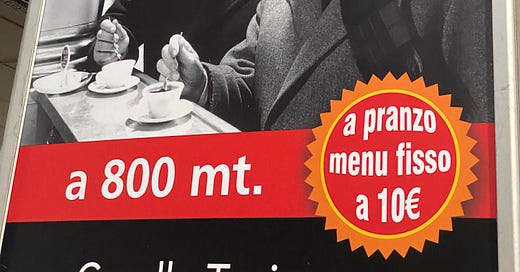Last weekend, my wife and I went to Asti in the Piemonte region of Italy to celebrate a close friend's wedding. Along the trip, we must have experienced something that was as close to the la dolce vita (the sweet life) as possible. Shocker. Italians have good food, good weather, and good quality of life. Yes. But, what exactly makes life so sweet in Italy? As an American now living in London, I’ve been on a quest to figure out: what are the right ingredients for a good life? I believe the answer lies somewhere between the American and European perspective, and I’d wager we can snag a few tips from our fellow Italians.
First some background. My wife did a study abroad trip when she was in high school, staying with a family in Asti, a small town in the northern region of Piemonte, close to Turin. Dotted along its rolling hills are vineyards known for producing some of the best wines in the world, including the famed Barolo and Barbaresco. We were in Asti for the wedding of the family’s daughter. Despite living in Asti, the family we were actually from Naples, a city which I love.
Last summer, my wife and I visited Naples for our honeymoon. I instantly felt a connection to the city. The people are mad, full of energy and passion. The streets are chaotic, filled with the blaring horns of motorbikes and men walking around in tight leather jackets. An aroma of espresso, burnt cigarette butts, and trash mixes in the air. The stench is cut by a faint sea breeze and wafts of bufala mozzarella melting in piping hot pizza ovens. Ah, just how I like it. After living in New York prior to London, I really missed a city with this kind of chaos. Cleanliness and safety are overrated. Anyhow, I digress. The keys to la dolce vita:
Ingredients
As I discovered multiple times over the weekend, one area that Napoletans get passionate about (other than their beloved football team) is food. On our weekend in Asti, the water in the home came all the way from Naples, Lete natural mineral sparkling water. This water is heavenly. It's lightly sparkling and packed with minerals, inducing a wonderful fizzy feeling permeating your head and nose. The coffee machine in the home, a De'Longhi, is a prized possession central to every major event of the day. Morning cappuccinos are made with love by the mother, followed by 1, 2, or 3 espressos that will naturally follow throughout the day and well into the evening. I say morning cappuccinos because they are only meant to be drunk before 10 am. Coming from London, where people seem to love drinking milk (I mean coffee) at all times of the day, this was odd. Later that day, I felt bad for another wedding guest from Austria who innocently ordered cappuccino after dinner, only to get completely roasted by all the Napoletans. Sucker!
So what about water and coffee? Surely the weekend was filled with more exciting food. Yes, of course it was. On the day of the wedding we sampled delicious pastas, risottos, wines from Alba and Asti, and an excellent hazelnut wedding cake. The reason, though, to write about these basic items is that in Italy, it really is about appreciation for basic ingredients. Showcasing the water, the coffee, the wine, seasonal fruits, vegetables and meat are what contributes to the delicious food and, the passion Italian people have for good ingredients is a certainly a key ingredient (no pun intended) to la dolce vita.
Portion sizes
Most people who know me reasonably well know that I’m basically at war with British people when it comes to drinking alcohol. Why on earth is the standard service size of any alcoholic drink in England 568 milliliters (1 pint)? Also, what the hell is a half pint? At a mere 250 milliliters, a half pint is so annoyingly small that one instantly feels sad for having ordered one. Meanwhile pretty much every other country in the world serves beer in 330 milliliters servings, a reasonably fulfilling middle ground. Given the issues we have with obesity and alcoholism, portion sizes for food and alcohol matter, and Italians have figured this one out too.
Over the weekend, we sampled many wines, prosecco, digestives, and beers. Not once during the wedding did I feel drunk, nor did I feel hungover the next day. Why? The average wine glass held something like 50-75 ml. Quite small you say? Perhaps. The perfect accompaniment to food? Bingo. Alcohol complements the food in Italy. The result is a dining experience involving a pleasant journey from aperitivo to primi, secondi, and dolce, all accompanied by various beverages designed to be savored in complement. Meals are finished with a deliciously nutty espresso to aid in digestion, leaving you feeling lightly energized but nourished. I wonder what life would be like if we adopted such portion control measures in the UK and US. I personally would prefer it to jumping on the new bandwagon of consuming overpriced sugary non-alcoholic beverages. Suffice to say, (smaller) portion sizes of food and alcohol are another key ingredient in la dolce vita.
Beauty
This might seem an odd one to point out, but Italian’s seem to care a lot about beauty. Throughout the weekend, I constantly heard the phrase “Che bello” or “Che bellissima” (translation: how beautiful!). Ok, yes we were at a wedding, so you could counter that it is common to hear these phrases. But it was more than that. I heard people calling out beauty everywhere. When discussing a quaint house nestled up along a hillside vineyard, or even when referring to food. Che Bello! Che Bello! Che Bello! I think I must have witnessed a few hundred people fall in love with everyday objects throughout the weekend. Fantastic. I love that Italians aren’t afraid to express their love for beautiful things. It certainly helps that the landscape, people, fashion and food are… well beautiful. But London is beautiful too! With its architecture, pubs and parks. There is beauty around us all and appreciating it is another key ingredient to la dolce vita.
Weather
Sun does seem to be a key factor in la dolce vita. Not sure what we can do about this in England but open for suggestions. ¯\_(ツ)_/¯
This is the first post in a new newsletter I’ve started called “Good Ingredients, Good Food” which focus on food, recipes, and restaurant recommendations. If you’ve enjoyed this post, feel free to subscribe to Good Ingredients Good Food here. And for those not interested, don’t worry, I’m still planning to write here on Seeking Solutions!
Thanks as always for reading and supporting my writing.






